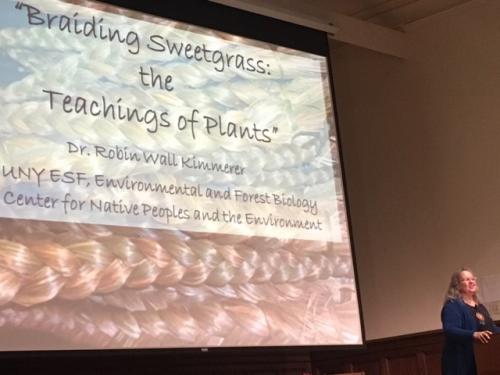Dr. Robin Kimmerer Delivers “Teaching of Plants” Lecture to Humanities Center

On February 13th, Dr. Robin Kimmerer (Distinguished Teaching Professor and Director of the Center for Native Peoples and the Environment, SUNY College of Environmental Science and Forestry) delivered a Franke Program in Science and Humanities Lecture to a packed auditorium at the Whitney Humanities Center. Entitled “The Teaching of Plants: Finding Common Ground between Traditional and Scientific Knowledge,” Professor Kimmerer’s lecture assessed the many ways that plants remain “among our oldest teachers” and provide guidance for maintaining and developing reciprocity with the natural world.
Assessing how plants also provide foundational understandings of ecological practice and discerning what such teachings reveal, Kimmerer extended analyses found in her prominent publications Gathering Moss: A Natural and Cultural History of Mosses and Braiding Sweetgrass: Indigenous Wisdom, Scientific Knowledge, and the Teaching of Plants. Dozens of students, staff, and faculty from across Yale College, the Yale School of Forestry and Environmental Studies (FES), and the Graduate School attended this highly anticipated event.
Current NACC member and FES graduate student, Noah Schlager, for example, attended Kimmerer’s lecture as well as a series of events on campus with her. As he relays,
“Robin Kimmerer spoke to students from the Yale School of Forestry and Environmental Studies during a lunch conversation that filled the conference room at Marsh Hall. Robin spoke to how she sees her work as braiding three distinct knowledge systems: western scientific canon, indigenous ecological knowledge, and the knowledge within plants themselves. She explained how each knowledge system has its own strengths and distinct contributions to make, and ought to not be blended together or pieced together in an uneven or undifferentiated way.
Paralleling Three Sisters agricultural arrangement, each knowledge system can remain distinct and yet contribute to a holistic understanding of the environment. Corn is like indigenous knowledge which provides the structure and history for the other two sisters to grow around. Scientific knowledge is like beans, which feed the corn with nutrients, but without the corn’s structural support would become a tangled mess. Squash, which acts as a living mulch in this system, and can be thought of as the knowledge of the plants as autonomous beings. She also reminded us that there is a forth sister, the person tending and providing the medium for these three sisters to come together in a complimentary way, which can be thought as our role as a discerning public.”
A member of the Citizen Potawatomi Nation, Professor Kimmerer also attended Professor Blackhawk’s “Writing Tribal Histories” class, doing so on the day when the class happened to be investigating Great Lakes Indian history and contemporary resource struggles. With long-standing community and academic ties to the region, she deepened the class’ engagement with themes of resource management and sustainability that are currently at the heart of many Oneida, Ho-Chunk, Ojibwe, Menominee, as well as Potawatomi tribal initiatives.

See also:
